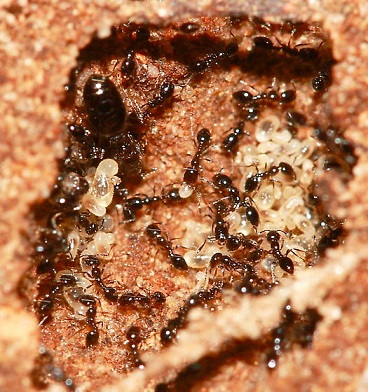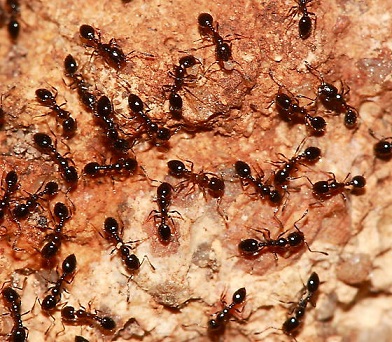Reproduction
As previously mentioned on the Habitat page, Monomorium minimum makes its home in various environments and conditions. These ants make their nests in relation to where they live, which is along wooded areas, roadsides, in flowerpots, brick walkways, wood piles, within the bark of trees, and in the soil (Bhatkar 1992, Keck 2005). They typically reproduce between May and August, usually the summer months depending on the region.
 Colony
structure, sex allocation and sperm transfer are crucial to
understanding mating success of M. minimum (Bhatkar 1992). The
colony structures of these ants are polygynous, which means that
there are several functionally reproducing queens. These
colonies contain
alate and dealated gynes, broods and workers. Alate females refer
to the winged form of the insect that are destined to become
queens, and alate males refer to the males that are destined to
become drones (Bhatkar 1992, Keck 2005).
Colony
structure, sex allocation and sperm transfer are crucial to
understanding mating success of M. minimum (Bhatkar 1992). The
colony structures of these ants are polygynous, which means that
there are several functionally reproducing queens. These
colonies contain
alate and dealated gynes, broods and workers. Alate females refer
to the winged form of the insect that are destined to become
queens, and alate males refer to the males that are destined to
become drones (Bhatkar 1992, Keck 2005).
Characteristically, the M. minimum fertile males and fertile queens have wings during breeding season, whereas the wingless females are the sterile workers (Smith 1965, Keck 2005, Stanley et al. 2012). The sex allocations of the colonies are sex biased (Sharkey 2007). They are either female or male dominant; however, at the population level there is a one to one sex ratio (Bhatkar 1992, Sharkey 2007). For the colonies that are dominant in males, there are high percentages of functional males with sperm; whereas the colonies that are female dominant have a high percentage of males without functional sperm (Bhatkar 1992, Sharkey 2007). When a colony does not display a sexual bias, both sexual types are dominant.
It has been demonstrated that allocolonial (between-the-colony mating)
is highly more successful than concolonial (within the colony mating).
According to one study, about 96% of 250 allocolonial matings between M. minimum were
successful in comparison to only 5.6% of 230 concolonial pairings
(Bhatkar 1992). Evidence suggests that only a few queen M. minimums
contribute to the sex-biased colonies while others produce the workers
(Bhatkar 1992). A colony may be polygyne, which means that there is more
than one queen per nest (Encyclopedia of Life 2013). These queens lay fertilized eggs simultaneously (Bhatkar
1992). Sex-bias in the colonies relates to allocolonial breeding rather
than the concolonial breeding.
 The actual mating action is quite interesting. This process is
initiated by the females who fly into a group of males, most likely
from another colony. These ants then proceed to perform this process out
in the open, usually on grass or fallen foliage (Bhatkar 1992). There
are several different responses that can be displayed. Males have to
orient themselves a certain way to the stationary female in order to
gain her attention (Bhatkar 1992); however, mating can occur during flight as well (Keck 2005). The mating responses occur with only a few or
all of the following responses. Mutual antenna touching can occur.
Another possibility could be rubbing the gaster (posterior end of the female) with hind
legs by the male while standing next to the female and/or the female
holding her wings in response to the male. The male could mount the
female, and pin her wings between his legs. The male would use his
antennae to lift the female gaster or the female raises her gaster. The
transfer of sperm would occur. The female bites the male’s gaster and
pulls him off with her mandibles (Bhatkar, 1992). This entire process
contributes to fertilazation and offspring to be produced. Most importantly, these unique mating strategies permit M. minimum to carry on
their existence.
The actual mating action is quite interesting. This process is
initiated by the females who fly into a group of males, most likely
from another colony. These ants then proceed to perform this process out
in the open, usually on grass or fallen foliage (Bhatkar 1992). There
are several different responses that can be displayed. Males have to
orient themselves a certain way to the stationary female in order to
gain her attention (Bhatkar 1992); however, mating can occur during flight as well (Keck 2005). The mating responses occur with only a few or
all of the following responses. Mutual antenna touching can occur.
Another possibility could be rubbing the gaster (posterior end of the female) with hind
legs by the male while standing next to the female and/or the female
holding her wings in response to the male. The male could mount the
female, and pin her wings between his legs. The male would use his
antennae to lift the female gaster or the female raises her gaster. The
transfer of sperm would occur. The female bites the male’s gaster and
pulls him off with her mandibles (Bhatkar, 1992). This entire process
contributes to fertilazation and offspring to be produced. Most importantly, these unique mating strategies permit M. minimum to carry on
their existence.
Interested in learning about how M. minimum plays with others? Find out by clicking Interactions.
Click here for References.
Click here to return to Home page.